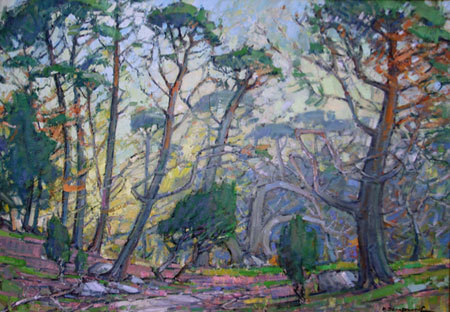 Oil painting is the method of painting with pigments that bound with means of drying oil, especially linseed oil in early modern Europe.
Oil painting is the method of painting with pigments that bound with means of drying oil, especially linseed oil in early modern Europe. The oil, such as linseed was simmered with pine resin or even frankincense, these were in oil painting used as varnishes and were esteemed for their splendor and glossiness. Other oils occasionally used in oil painting include poppy seed oil, walnut oil, and safflower oil. These oils give a variety of properties to the oil paint, such as less staining or different drying times.
The oil, such as linseed was simmered with pine resin or even frankincense, these were in oil painting used as varnishes and were esteemed for their splendor and glossiness. Other oils occasionally used in oil painting include poppy seed oil, walnut oil, and safflower oil. These oils give a variety of properties to the oil paint, such as less staining or different drying times. Certain differences are also visible in the luster of the paints depending on the oil. Painters often use different types of oils in the same painting depending on specific pigments and desired effects. The paints themselves also develop a particular feel depending on the media.
Certain differences are also visible in the luster of the paints depending on the oil. Painters often use different types of oils in the same painting depending on specific pigments and desired effects. The paints themselves also develop a particular feel depending on the media. These techniques can be contemplated in the oil painting lessons in Florence.
These techniques can be contemplated in the oil painting lessons in Florence.Traditionally, painting was performed with paint brushes, but there are other methods, including the palette knife, the rag, and even directly from the paint tube. Oil paint remains wet longer than many other types of artists' materials, so a reality in many painter's studios is the removal of oil paint from the painting.
 This can be done with a rag and some turpentine for a certain time while the paint is still wet, but after a while, the if the layer is hard it must be scraped. Oil paint dries by oxidation, not evaporation, and is usually dry to the touch in one to fifteen days
This can be done with a rag and some turpentine for a certain time while the paint is still wet, but after a while, the if the layer is hard it must be scraped. Oil paint dries by oxidation, not evaporation, and is usually dry to the touch in one to fifteen daysIn the oil painting lessons in Italy, you will learn that the oil paint application is 'fat over lean' which means that each layer of paint must be oilier than the one underneath, to allow proper drying. There are many other painting media that can be used in oil painting, including cold wax, resins, and varnishes.
No comments:
Post a Comment